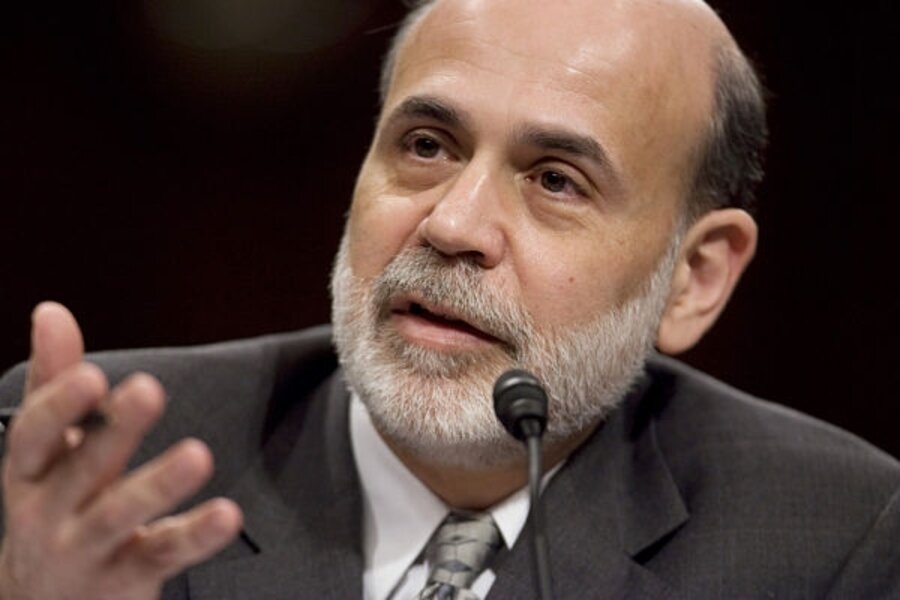Bernanke’s plan to tame Wall Street
Loading...
| New York
Call it Ben Bernanke’s blueprint for reform – a new architecture to prevent future financial meltdowns and trillion-dollar government interventions.
To accomplish it, the Federal Reserve chairman is calling for sweeping changes that would put all financial institutions under the hot lights of a new super-regulator. This government overseer would not only assess risk in the financial sphere, but also have authority to correct imbalances before they threaten the entire world economy.
This could temper Wall Street’s ability to devise new financial instruments, which created much wealth in the past 20 years but which also led to today’s tottering markets.
Although Mr. Bernanke has testified before Congress many times since the financial crisis began, Fed observers say this is his first presentation of a comprehensive plan.
“This is the first time he has stepped to the plate and done what is necessary,” says Doug Roberts, director of research at Channel Capital Research in Shrewsbury, N.J. “He’s saying you have to update the system for the 21st century.”
Four reforms
In a speech Tuesday before the Council on Foreign Relations in Washington, Bernanke laid out four areas of reform:
•Toughen regulations for financial institutions deemed “too big to fail.”
•Strengthen the financial infrastructure to ensure it performs under stress.
•Make sure that banks lend money during bad times as readily as they do during good times.
•Form a Systemic Risk Authority tasked with spotting problems before they threaten the entire financial system.
“It’s not too soon for policymakers to begin thinking about the reforms to the financial architecture, broadly conceived, that could help prevent a similar crisis from developing in the future,” Bernanke said in his speech. “Until we stabilize the financial system, a sustainable economic recovery will remain out of reach.”
Too big to deal with?
A key reform is dealing with the problem of financial institutions that have become so gigantic their failure could result in a global economic meltdown. That is one reason the government has pumped hundreds of billions of dollars into institutions such as insurance giant AIG and banking behemoths Citigroup and Bank of America.
“What Bernanke wants to do is supervise individual organizations and groups so we don’t get into this kind of problem in the future,” says Lyle Gramley, a former Fed governor. “There is no question we are heading for much more regulation, and we need it.”
If an organization becomes “too big to fail,” Bernanke says, it encourages excessive risk-taking by the firm and “provides an artificial incentive for firms to grow, in order to be perceived as too big to fail.”
To identify future systemic risks, Bernanke would like to establish a “super-regulator” that he calls the Systemic Risk Authority. He suggests that Congress “direct and empower a governmental authority to monitor, assess, and if necessary, address potential systemic risks within the financial system.”
Two problems that might have been spotted by such an authority, says Bernanke: AIG and the subprime lenders.
To Mr. Gramley, the Systemic Risk Authority sounds like a job for the Federal Reserve. “I can’t think of anyone else,” he says. “It does involve an expansion of the Fed’s responsibility and puts a lot more burdens on the government, but I don’t see much alternative.”
Bernanke wants to ensure, too, that the financial system will perform better in the future. The Fed is currently running a computer test of major banks to see how they would perform under an even worse economy over the next two years. But Bernanke also wants to certify that what he terms the “financial plumbing” is ready to withstand “future shocks.”
Citing an example, he said the Federal Reserve Bank of New York “has been leading a major joint initiative by the public and private sectors to improve arrangements for clearing and settling credit default swaps and other over-the-counter derivatives.” Credit default swaps are complex financial instruments that help insure against large corporations defaulting on their loans. Concern is growing about the risk they pose to the financial system, because banks may have to pay investors if, amid recession, companies fail to pay their debts.
Eye on capital rules
To get banks to lend more money in down times, Bernanke said, the Fed may need to examine its own capital rules.
“Because banks typically find raising capital to be difficult in economic downturns or periods of financial stress, their best means of boosting their regulatory capital ratios during difficult periods may be to reduce new lending, perhaps more so than is justified by the credit environment,” he explained. “We should review capital regulations to ensure that they are appropriately forward-looking and that capital is allowed to serve its intended role as a buffer – one built up during good times and drawn down during bad times.”
However, later, in a question and answer period, Bernanke said he is opposed to making changes to the “mark to market” accounting rules that cause banks to write down the value of their assets as the economy sours. That kind of transparency, he said, is essential for investors.
Many Americans worry that this recession will become a depression. But Bernanke noted that the Fed is behaving differently than it did during the Great Depression, when it shrank the money supply. In this downturn, the Fed has provided trillions of dollars in new funds. Moreover, he said, monetary authorities failed to grasp the ramifications of the 1931 failure of Creditanstalt, a large Austrian bank. Today, he has said, the Fed will not allow any major bank to collapse.





